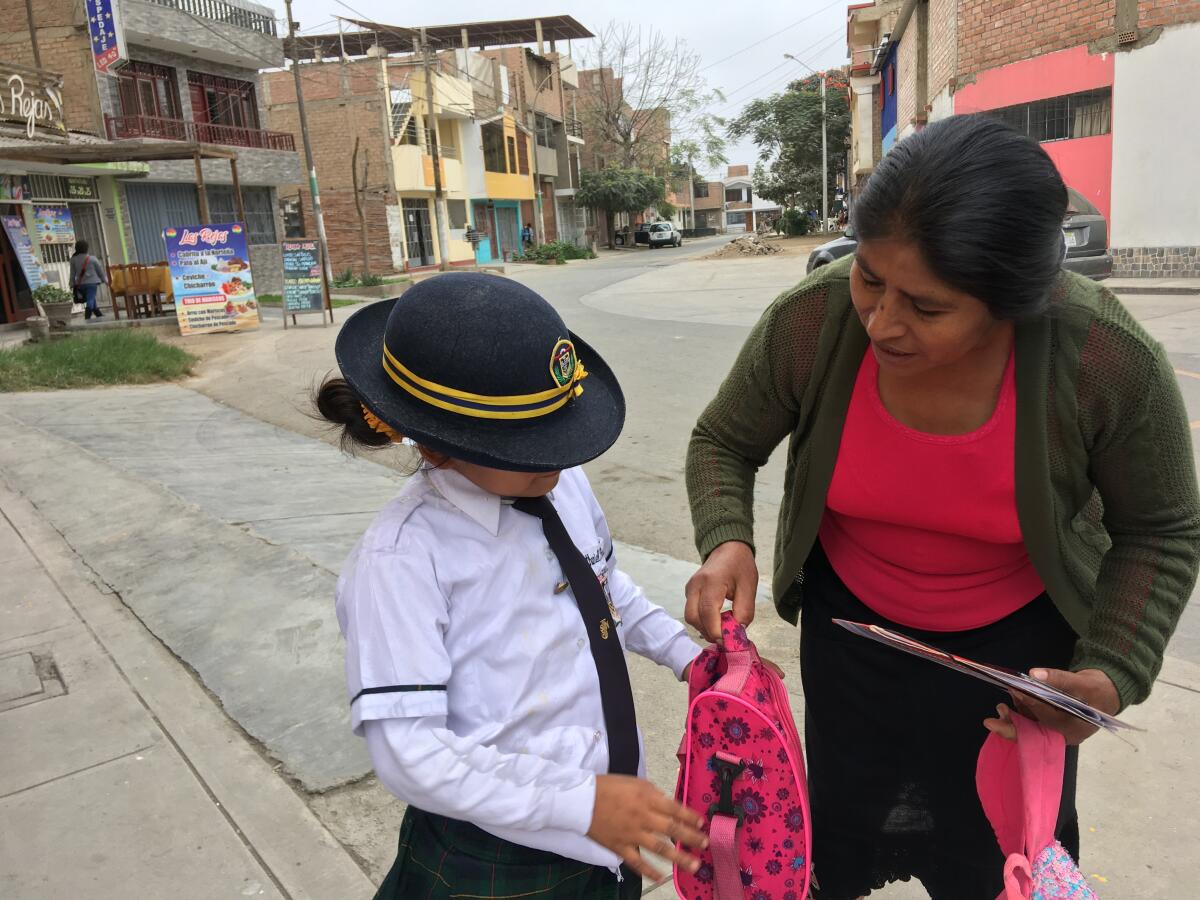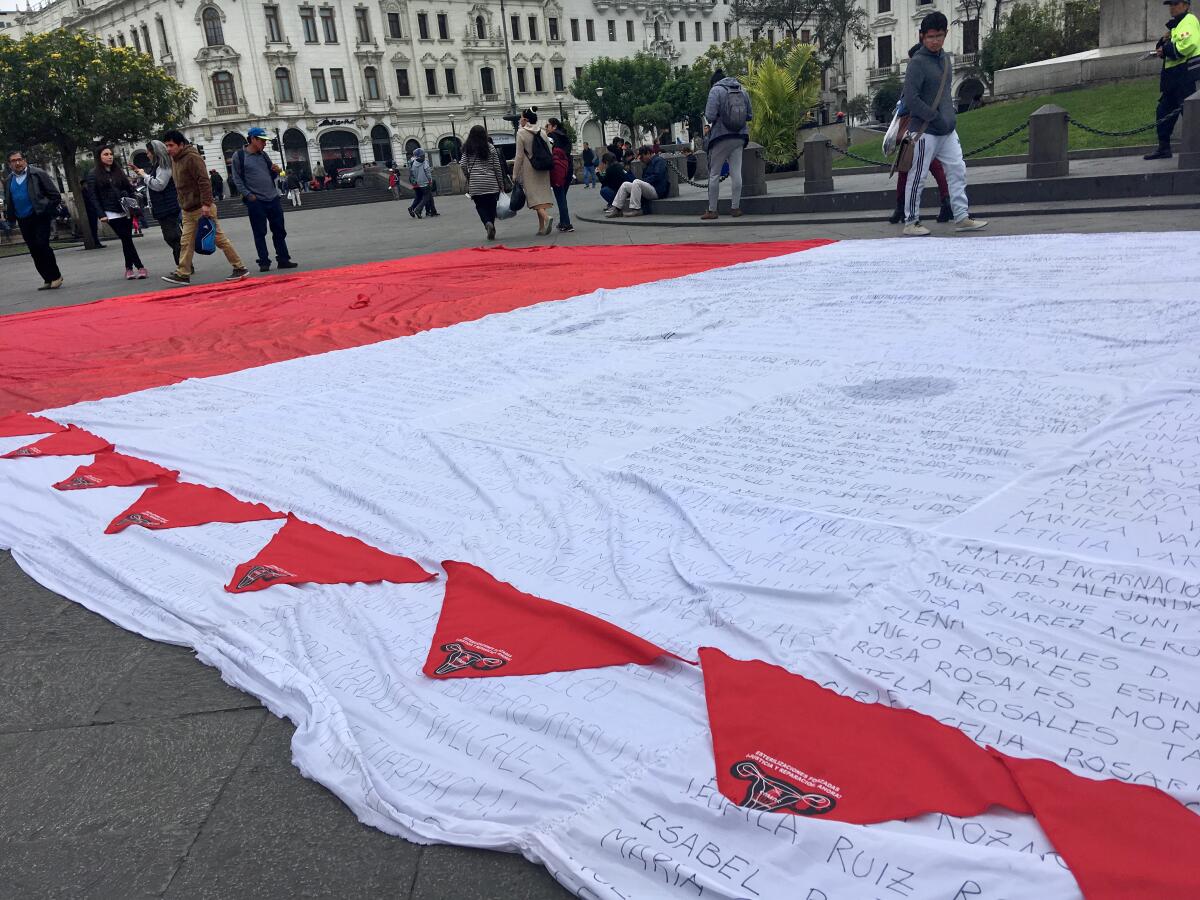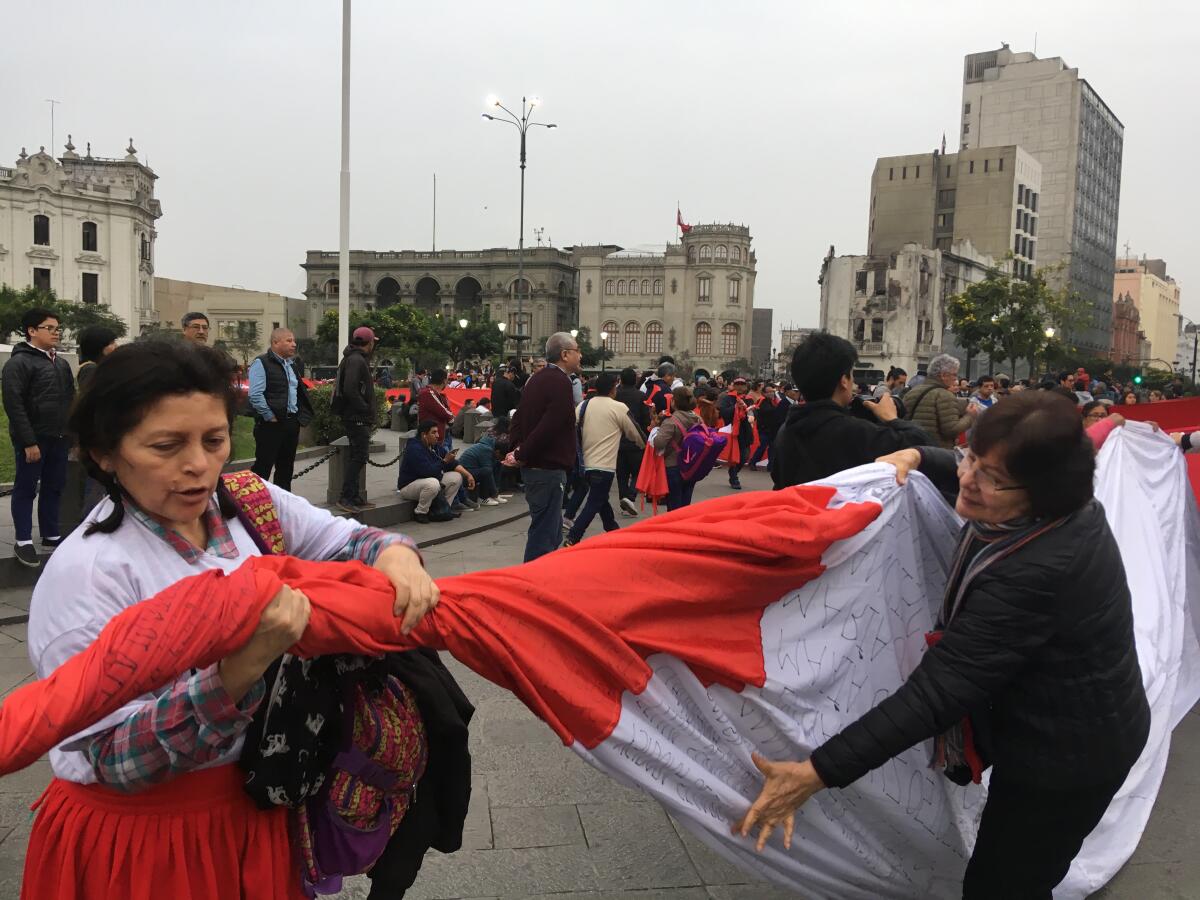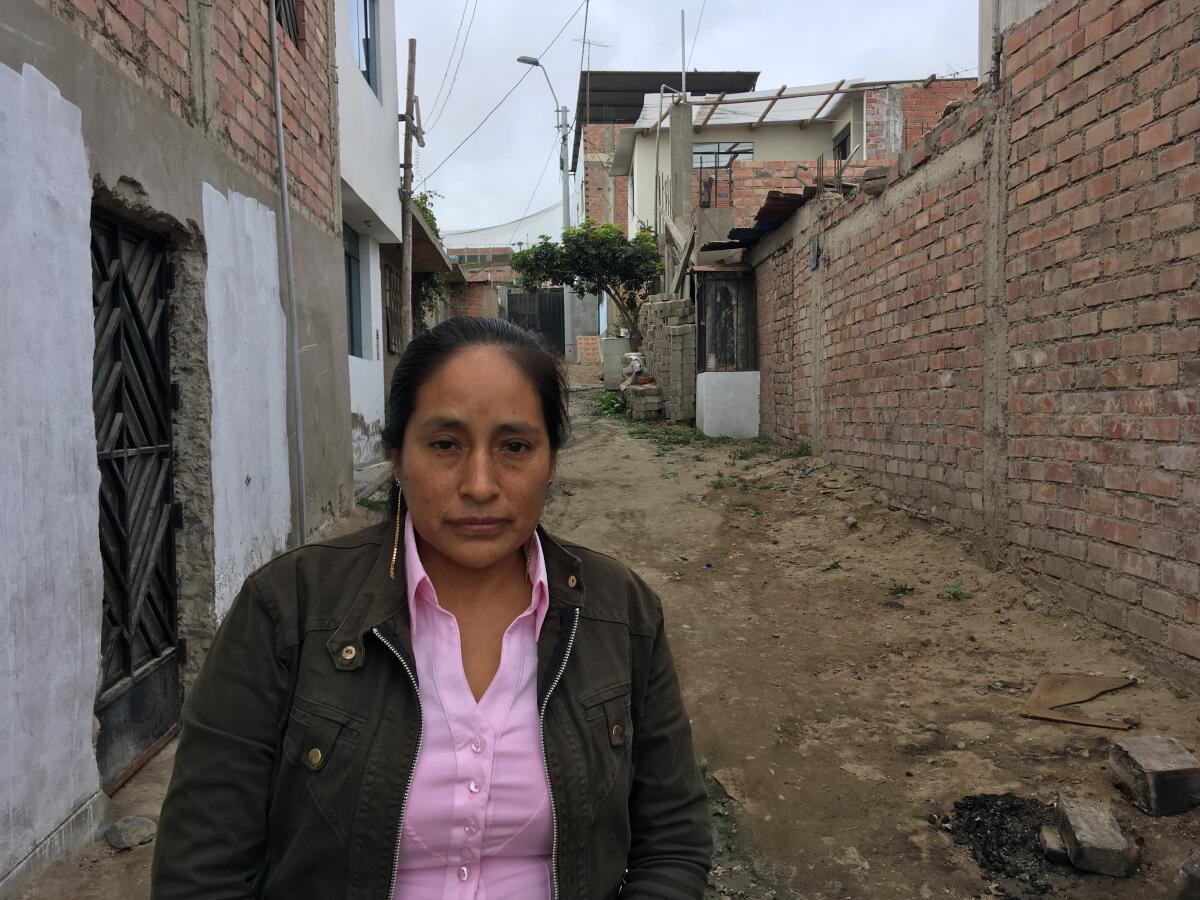Tied down and sterilized: Peru’s dark history of family planning

- Share via
LIMA, Peru — The first time nurses visited Gloria Basilio, she told them she wasn’t interested in sterilization surgery. She already had three children but wanted more.
The nurses kept returning to her home in the remote Peruvian countryside. They told her the president himself had ordered the procedure for women with large families — women who they said “reproduced like rabbits.”
With her husband away, Basilio finally conceded.
She changed her mind in the operating room the next day, but nurses tied her arms and legs to a bed and blindfolded her.
Basilio is one of untold thousands of women — mostly poor, rural and indigenous — who were sterilized against their will under a family planning program that operated from 1996 to 2000 under the government of then-President Alberto Fujimori.
The government has said more than 272,000 women and 22,000 men received sterilizations. As of September, nearly 7,500 people — 96% of them women — had joined a government registry claiming they never consented.
“My husband never stopped blaming me,” said Basilio, now 46. “He also wanted more children. Whenever I complained about the pain, he told me, ‘Why did you do that to yourself? Why did you get the operation?’”
Now, after nearly two decades of sputtering attempts at justice by Peru, Fujimori and three of his former health ministers are facing prosecution on charges of human rights violations.
The criminal complaint, which was filed last year on behalf of more than 1,300 people, including five women who prosecutors say died as a result of complications from the procedure, has reached a critical juncture. A court specializing in high-level corruption is scheduled to hear evidence in early December and decide whether the case can proceed.
Basilio said she also wants a public apology — “even from Fujimori.”

His government’s family planning program was once hailed as a way to reduce widespread poverty by ensuring that low-income and less educated families would receive the same access to birth control as higher-income families.
“Peruvian women should be the owners of their destiny!” Fujimori declared in a 1995 speech to congress.
But prosecutors allege that the campaign emphasized sterilization over other contraceptive measures and that healthcare workers were pressured to meet quotas.
They say that the president participated in meetings with health ministers that focused on sterilization and that he received written updates on the alleged campaign to operate on women.
The doctors “obeyed a scale of orders that were controlled by the highest level of the country,” said Milton Campos, an attorney at DEMUS, a Peruvian women’s rights group representing accusers.
::
Almost from the beginning, the family program was dogged by complaints that women were being coerced.
Forced sterilizations are considered a crime against humanity under international law, and various inquiries by the government and activists eventually led to a criminal investigation, which has been opened and closed several times over the years.
The most significant upshot was a 2003 settlement before the Inter-American Commission on Human Rights in which Peru agreed to pay compensation to the family of a woman who died after being forcibly sterilized.
Fujimori, who resigned the presidency in 2000 after corruption scandals involving his former spy chief, is serving a 25-year prison sentence for ordering massacres during his government’s fight against Maoist rebels.
But his political allies — known as fujimoristas — continued to maintain considerable power as well as a populist image.
The sterilization case “complicates the fujimorista narrative — that they are in favor of the people, in favor of the poor,” said Jo-Marie Burt, a political scientist and Peru expert at George Mason University.
Then in 2016, the Justice Ministry began registering accusers in hopes of providing them psychological, medical and legal assistance, as well as determining the scope of the sterilization campaign.
Melissa Goytizolo, a Peruvian journalist who has gathered accounts of more than 100 accusers, reported that some were sterilized while unconscious after a caesarean section.
Others said they were told they were being treated for malaria, then anesthetized and sterilized. Some women caved to threats that resisting the surgery would send their husbands to jail.
In other cases, indigenous women signed consent forms they didn’t understand — because they couldn’t read Spanish.
The 2018 complaint describes fairs held to gather large groups of people who would be good candidates for sterilization. Potential targets were offered food and clothes as incentives.
Other details have come from Hernando Cevallos, a former congressman and one of the few doctors to speak out about the program. He was head of the medical federation in Peru’s Piura region in 1997 when a group of doctors alleged that health officials had ordered them to perform 250 sterilizations in four days.
To meet quotas, personnel at medical facilities — down to the cleaning staff — would be mobilized to bring in patients, Cevallos said.
“There was a lot of fear among doctors because these were orders from the state,” he said. “You knew it was wrong, you knew it increased the risk, but you did it, because if not, you could be dismissed.... It was really like a sterilization factory.”

::
The accused and their allies have denied the existence of a sterilization campaign.
Cesar Nakazaki, Fujimori’s attorney, said that the president was not involved in running the program and although in some instances doctors did not get consent, that doesn’t mean it was government policy.
“A high percentage of children in the Andes die every year from the cold,” he said. “Does that mean that there’s a health policy for those children to die? No.”
In a 2015 speech at Harvard, the former president’s daughter, Keiko Fujimori, said that the forced sterilizations were the “personal responsibility of doctors who did not respect the protocols.”
Marino Costa Bauer, one of the former health ministers facing charges, called the family planning campaign an “excellent” program that reduced the maternal mortality rate.
“Could there have been some cases where there wasn’t adequate consent? Surely,” he said. “The program had very clear regulation. If it wasn’t followed, that wasn’t the fault of the minister or of the ministry, but of the ones who didn’t comply.”
Costa Bauer has argued that the case has gone on too long and is waiting on Peru’s top court to rule on a petition seeking to close it.
::

Victims of the sterilization campaign were often abandoned by their husbands, who viewed them as useless.
“It’s difficult for them to find another partner because they are already stigmatized as a woman who cannot have children,” said Alejandra Ballon, who wrote a book in 2014 on the sterilizations. “In the Andean or Amazonian culture, where the more children you have the better, it’s very difficult for them.”
That was the case for Maria Elena Carbajal, who said that hours after giving birth in 1996 she relented to pressure from doctors at the hospital and was sterilized.
She said that when her husband learned what had happened, he accused her of having the operation so she could have another sexual partner.
“My husband abandoned me from that day,” said Carbajal, now 49. “He forgot about me and my children.”
Carbajal was tasked with supporting her four children on her own. She eventually found a new partner, but said their relationship eventually ended because she could not provide him children.
Today she leads a victims’ association in Lima that meets monthly and offers group therapy.

One member, Florentina Loayza, who was allegedly sterilized at 19 after being held down and anesthetized, said that before receiving therapy, she would feel a deep sadness whenever she saw children.
“I went to the market and the first thing I saw was baby clothes or I saw a child and I wanted to have a child,” said Loayza, who is now 40. “I don’t have that longing anymore.”
Advocates for victims say most receive little or no help.
Raquel Reynoso, who helps lead an association seeking reparations, said there is a shortage of psychologists at the health centers in the far-off areas where many of the women live.
“They don’t even receive adequate medical attention, which is the most basic thing they ask for,” she said.
The Ministry of Health and the Ministry of Women and Vulnerable Populations, both tasked with helping the victims, did not answer requests for comment.
Meanwhile, growth of the registry of victims has slowed considerably. The justice ministry works with victims’ associations to arrange multi-day visits to communities in search of more cases.
Joshua Calderon, a justice official who coordinates legal assistance for victims, said his team has focused on the regions where there have been reports of forced sterilizations.
“It’s logical that there could be a number of citizens that have still not registered, and with more money for this service we could reach a higher number,” he said.
Goytizolo, the journalist, blamed the government for investing too little in the effort. Several years ago, she and Ballon, the author, demonstrated how it could be done.
In Pucallpa, a city in the Amazonian rainforest, they bought a call-out on local radio instructing women who felt they had been tricked into sterilization to contact the station. It led them to dozens of accusers.
“This program affected women who were farmworkers, the poorest, with the least education, and that’s why the state doesn’t help them,” Goytizolo said. “I think these are the most forgotten women in Peru.”
This story was reported with support from the International Center for Journalists.
More to Read
Sign up for Essential California
The most important California stories and recommendations in your inbox every morning.
You may occasionally receive promotional content from the Los Angeles Times.











